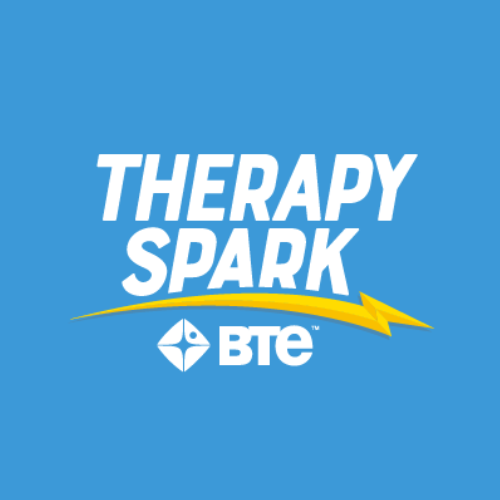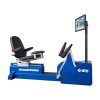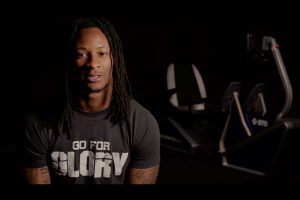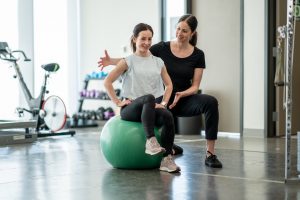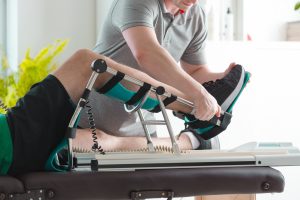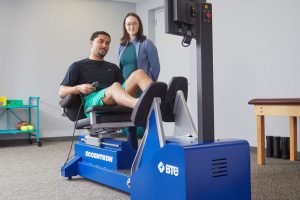
ACL Reconstruction Rehabilitation Guide for Clinics: Equipment & Processes
Treatment GuidelinesTransform your ACL rehabilitation program with this comprehensive guide. Discover criteria-based protocols, objective testing methods, and return-to-sport criteria that drive superior outcomes, enhance patient engagement, and differentiate your practice in today's competitive healthcare market.
ACL reconstruction rehabilitation has evolved beyond time-based protocols. Today’s evidence-based approach relies on objective, criteria-based progression through five distinct phases. Success requires measurable milestones, comprehensive strength testing, and psychological readiness assessment before return to sport. Modern rehabilitation equipment enables clinicians to capture objective data, standardize protocols, and demonstrate clear patient progress—transforming both clinical outcomes and practice efficiency.
How to Upgrade Your ACL Rehab Program
Let’s face it—ACL reconstruction rehabilitation represents one of the most challenging and critical services you provide. With over 200,000 ACL reconstructions performed annually in the United States alone, and re-injury rates hovering between 25-30% when protocols aren’t optimized, the stakes couldn’t be higher.
If you’re still following the traditional “you’re six months post-op, so you can return to sport” approach, you’re not just behind the curve—you’re potentially compromising patient outcomes and leaving money on the table. Inconsistent, time-based protocols create a cascade of problems that impact every level of your organization:
- Poor patient satisfaction that damages your referral network
- Extended recovery timelines that strain your resources
- Documentation challenges when justifying care to payers
- Zero differentiation from every other clinic in your market
The solution? A modern, criteria-based approach powered by objective data. This guide will show you how to implement an ACL rehabilitation program that accelerates recovery, engages patients with measurable progress, and positions your clinic as the regional leader in orthopedic care.
The Foundation: Embracing Criteria-Based Progression
The old model of ACL rehab—where progression depends on time since surgery—is fundamentally flawed. Every patient heals differently. Some achieve full quadriceps activation within days; others struggle for weeks. By moving to criteria-based progression, you’re acknowledging this reality and adapting your treatment accordingly.
It’s important to recognize that a criterion-based approach does not disregard tissue healing timelines. These timelines remain essential and must be respected to ensure safe and optimal patient progression. Graft selection must also be considered when determining loading parameters and progressions. As clinicians working with ACL inuries, we must understand the varying healing timelines associated with different graft types, as well as other influencing factors such as multi-ligament involvement, meniscal injuries, concomitant fractures, etc.
Here’s what this means for your practice: instead of advancing patients because “it’s been 12 weeks,” you progress them when they’ve achieved specific, measurable milestones with respect to tissue healing timelines. Think 90% limb symmetry in strength testing. Full knee extension without compensation. Single-leg balance held for 30 seconds without wavering.
For clinicians, this approach empowers you to make individualized, evidence-based decisions. For clinic owners and administrators, it creates a defensible standard of care that you can market to referring physicians and showcase to potential patients. When you can say, “We use objective testing equipment like the PrimusRS to ensure each patient meets specific strength criteria before advancing,” you’re speaking a language that resonates with both medical professionals and informed consumers.
Phase 0: The Competitive Advantage of Pre-Operative Rehabilitation
Here’s something most clinics miss: rehabilitation should start before surgery. We call this Phase 0, and it might be your biggest opportunity to differentiate your services.
Pre-operative rehabilitation focuses on three critical goals:
- Reducing swelling to baseline levels
- Restoring full range of motion
- Achieving >90% quadriceps strength symmetry
Why does prehab matter? Patients who enter surgery with better knee function experience faster post-operative recovery and superior long-term outcomes.1 From a business perspective, you’re creating an early touchpoint that builds trust and virtually guarantees the patient returns for post-operative care.
Using equipment like the PrimusRS, clinicians can objectively measure pre-operative strength deficits and establish baseline data that guides the entire rehabilitation journey. This isn’t just good medicine—it’s smart business.
The Complete Six-Phase Protocol: Your Roadmap to Excellence
Phase 1: Immediate Post-Operative (Weeks 0-2)
The immediate post-operative phase sets the foundation for everything that follows. Your primary goals include controlling pain and swelling, achieving full knee extension, and activating the quadriceps.
Essential interventions during this phase:
- Cryotherapy and compression therapy
- Quadriceps sets (10-15 reps, hold 5 seconds)
- Heel slides for gentle range of motion
- Straight leg raises in multiple planes
- Closed-chain leg exercises
- Patellar mobilization techniques
The key to success in Phase 1? Gradual activation that builds confidence. Get patients moving early post-op to keep them focused on returning to function. Equipment like the Eccentron enables patients to start gentle, closed-chain movement from day one, creating a strong foundation for success.
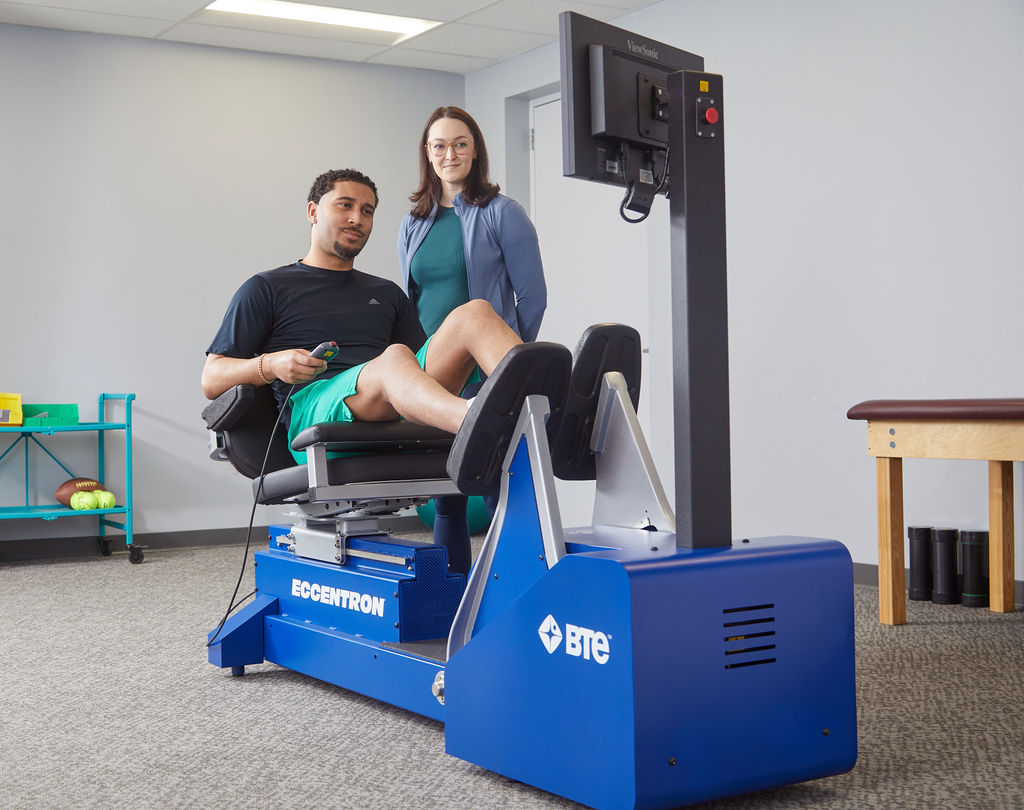
Phase 2: Early Rehabilitation (Weeks 2-6)
As patients progress to Phase 2, the focus shifts to normalizing gait patterns, improving range of motion, and building foundational strength.
Your exercise arsenal expands to include:
- Mini-squats (0-45 degrees initially)
- Leg press with controlled resistance
- Stationary bike for low-impact cardiovascular conditioning
- Standing hip abduction and extension
- Balance training on stable surfaces
This is where objective assessment really shines. Rather than relying on visual gait assessment alone, advanced rehabilitation equipment allows clinicians to quantify gait symmetry and identify compensatory movement patterns early. The PrimusRS provides versatile resistance training options while capturing precise strength measurements that guide your clinical decisions.
Phase 3: Strengthening & Neuromuscular Control (Weeks 6-12)
Phase 3 marks a critical transition point where you’re building the strength and control necessary for more demanding activities. The goals are clear: regain full strength, enhance proprioception, and develop dynamic stability.
Progressive exercises include:
- Single-leg squats with proper form
- Forward and lateral lunges
- Step-downs with eccentric control
- Proprioceptive training on unstable surfaces
- Early plyometric preparation (bilateral before unilateral)
Here’s where the Eccentron becomes particularly valuable. Eccentric exercise requires significantly less oxygen consumption while allowing higher loading capacity—perfect for building strength when the reconstructed ACL is still vulnerable. Research shows that ACL rehabilitation with Eccentron yields higher quadriceps and gluteus maximus gains in size, strength, and function compared to standard treatment protocols.2
The Eccentron’s game-like target force display promotes neuromuscular reeducation as patients learn to control their eccentric force in each leg. By tracking limb symmetry index throughout this phase, you’re providing patients with clear, visual feedback on their progress while building the objective documentation that supports continued care.
Phase 4: Advanced Training & Agility (Weeks 12-16)
Phase 4 prepares patients for the demands of sport or work-specific activities. This is where rehabilitation transforms into performance training.
Advanced interventions include:
- Box jumps and depth jumps
- Agility ladder drills
- Cutting and pivoting progressions
- Sport-specific movement patterns
- Reactive neuromuscular training
The ability to analyze muscle firing patterns and power output becomes crucial here. Equipment that provides real-time feedback helps clinicians identify asymmetries that might not be visible to the naked eye. For sports performance centers, this level of objective data represents a major differentiator. For hospital systems, it enables standardized protocols across multiple facilities.
During Phase 4, Eccentron can provide up to 750lbs of force per limb – enough to challenge your most powerful athletes. The on-screen force targets teach patients to control every rep through the entire range of motion, even at high forces. When your athlete is ready to practice sport-specific exercises, PrimusRS has versatile attachments and resistance modes to replicate movements for soccer, basketball, football, tennis, and more.
Phase 5: Return to Sport/Work Testing (Weeks 16-24+)
Phase 5 isn’t just another progression—it’s a critical decision point. The question isn’t “Has enough time passed?” but rather “Has this patient met all objective criteria for safe return to activity?”
Objectively testing athletes on the exact movements of their sport is crucial for a safe return. The PrimusRS allows clinicians to simulate any sport movement with precision for both objective evaluations and progressive functional training.
Watch: Return to Sport Testing on PrimusRS
Phase 6: Maintenance phase
With re-injury rates in the ACL population ranging from 25–30%, it’s critical to recognize the importance of ongoing maintenance through a targeted exercise program. Evidence-based protocols like the FIFA 11+ have been shown to significantly reduce the risk of secondary ACL injuries by incorporating functional movements that enhance strength, stability, mobility, agility, proprioception, and sport-specific movements.
Incorporating similar principles using the PrimusRS offers an excellent option for continued performance training. In addition, the ability to conduct follow-up assessments with the PrimusRS testing battery ensures that athletes maintain optimal muscular performance and remain on track in their long-term success.
Beyond the Timeline: Objective Return-to-Sport Criteria
This is where many ACL rehabilitation programs fall short. Return-to-sport decisions should never be based on time alone. Instead, you need a comprehensive testing battery that evaluates multiple domains of function.
The Essential Test Battery
Strength Testing: Using isokinetic or handheld dynamometry, you’re looking for:
- Quadriceps strength >90% limb symmetry index
- Hamstring strength >90% limb symmetry index
- Hamstring-to-quadriceps ratio within normal limits
Functional Hop Testing: The gold standard includes:
- Single hop for distance (>90% LSI)
- Triple hop for distance (>90% LSI)
- Crossover hop for distance (>90% LSI)
- 6-meter timed hop (<10% difference between limbs)
Movement Quality Assessment: Tests like the Landing Error Scoring System (LESS) help clinicians evaluate biomechanical risk factors during dynamic activities.
Normative Data: For certain populations, normative data is available to compare an individual’s performance to that of their peers. For example, if you are working with a high school female soccer player returning to sport, research has established average single-leg triple hop distances for this specific group. Using these normative values provides a more meaningful assessment of readiness by contextualizing performance against the athletes she’ll be competing with. This distinction is important—if the athlete demonstrates a 90% limb symmetry index but still performs well below her peers, she may still be at an increased risk for reinjury despite appearing “ready” based on symmetry alone. Using available normative data in combination with LSI’s takes this essential testing battery to the next level.
The Overlooked Factor: Psychological Readiness
Here’s what separates good ACL rehabilitation from great: acknowledging that physical readiness is only part of the equation. The ACL-Return to Sport after Injury (ACL-RSI) scale quantifies an athlete’s psychological readiness, measuring confidence, fear of re-injury, and risk appraisal.
Patients who score below 60% on the ACL-RSI have significantly higher re-injury rates, regardless of their physical test results. By incorporating psychological assessment into your return-to-sport protocol, you’re demonstrating a level of sophistication that builds trust with athletes, coaches, and referring physicians.
Building Your Premier ACL Program: The Path Forward
The transformation from time-based to criteria-based ACL rehabilitation isn’t just an upgrade—it’s a complete paradigm shift. By implementing objective testing protocols, leveraging advanced rehabilitation equipment, understanding individualized tissue healing timelines and addressing both physical and psychological readiness, you’re creating a program that delivers superior outcomes while differentiating your practice in a competitive market.
Consider how equipment like the PrimusRS enables clinicians to provide objective strength assessments and dynamic exercise throughout the rehabilitation journey. Or how the Eccentron provides effective eccentric training that research shows accelerates strength gains. These aren’t just tools—they’re the foundation of a data-driven approach that elevates your entire practice.
The benefits extend beyond clinical outcomes. With objective data supporting every decision, you’re better positioned to:
- Justify continued care to insurance providers
- Demonstrate value to referring physicians
- Engage patients with clear progress metrics
- Standardize excellence across multiple practitioners or locations
Your next step? Start implementing these evidence-based protocols in your practice. Download assessment templates, establish your testing battery, and begin capturing the objective data that transforms good rehabilitation into exceptional care.
Remember, in today’s healthcare environment, subjective assessment and time-based protocols aren’t just outdated—they’re a liability. The clinics that thrive will be those that embrace objective measurement, criteria-based progression, and comprehensive care that addresses every aspect of recovery.
The question isn’t whether to upgrade your ACL rehabilitation program. The question is whether you’ll lead the change in your market or follow someone else who does. The choice—and the opportunity—is yours.
ACL Reconstruction Rehabilitation FAQs:
- When can patients begin weight-bearing activities after ACL reconstruction?
Weight-bearing progression depends on the surgical technique and surgeon’s protocol, but typically follows this timeline: Immediate post-op (0-2 weeks) allows toe-touch to partial weight-bearing with crutches and a locked brace at 0 degrees. By 2-4 weeks, patients can progress to full weight-bearing as tolerated if they demonstrate good quadriceps control and minimal swelling. Always verify the specific surgeon’s weight-bearing restrictions before advancing patients, as protocols can vary based on graft type (patellar tendon, hamstring, or allograft) and any concurrent procedures like meniscal repair.
- What are the key criteria for progressing patients between rehabilitation phases?
Progression should be based on functional milestones rather than time alone. For Phase 1 to Phase 2 (2 weeks): Full passive knee extension, minimal effusion, and independent straight leg raise. For Phase 2 to Phase 3 (6 weeks): ROM of 0-120 degrees, normalized gait without assistive devices, and quadriceps strength at least 60% of uninvolved side. For Phase 3 to Phase 4 (12 weeks): Full ROM, quadriceps strength 80% of uninvolved side, and successful completion of closed-chain exercises without pain. Always assess movement quality, not just strength numbers, and ensure patients meet psychological readiness markers.
- Are open kinetic chain exercises safe during ACL rehabilitation?
Yes, when performed correctly and at appropriate times. Current evidence shows open kinetic chain exercises can be safely introduced around 6-8 weeks post-surgery when performed in a restricted ROM (typically 90-45 degrees for knee extension). Avoid the last 30 degrees of extension during early phases as this places highest stress on the ACL graft. These exercises are valuable for isolated quadriceps strengthening and addressing strength deficits. Always monitor for anterior knee pain, effusion, or patient apprehension, and progress resistance gradually while maintaining proper form.
- How do we assess if a patient is ready to return to sport activities?
Return-to-sport decisions require multiple objective and subjective criteria, typically evaluated at 4-6 months post-surgery. Objective measures include: quadriceps and hamstring strength within 90% of uninvolved limb, successful completion of hop tests (single hop, triple hop, crossover hop) with >90% limb symmetry index, and normal movement patterns during cutting and landing tasks. Subjective measures include psychological readiness assessed through tools like the ACL-RSI scale, patient-reported confidence levels, and absence of fear-related movement compensations. Final clearance always requires physician approval and sport-specific functional testing.
- What precautions should we take when treating patients with different ACL graft types?
Graft type influences rehabilitation timelines and precautions. Patellar tendon grafts may require additional attention to anterior knee pain and patellar mobility, with gentle patellar mobilization starting early. Hamstring grafts typically have less anterior knee pain but may show slower hamstring strength recovery, requiring focused posterior chain strengthening. Allograft patients may progress slightly slower initially due to incorporation timeline. All grafts require avoiding excessive anterior tibial translation forces early on. Always confirm specific surgeon protocols, as some may have graft-specific restrictions for pivoting activities or certain exercise progressions.
- How do we address common complications like anterior knee pain or quadriceps weakness?
Anterior knee pain is common, especially with patellar tendon grafts. Address through patellar mobilization, proper patellofemoral mechanics training, and avoiding aggravating activities like prolonged sitting or stairs initially. Use modalities like ice after exercise and consider taping techniques for patellar tracking. For quadriceps weakness, which affects up to 20% of patients long-term, implement early quadriceps activation exercises (quad sets, electrical stimulation if needed), progress to closed-chain exercises emphasizing proper mechanics, and address any underlying swelling that inhibits muscle function. Monitor for quadriceps avoidance patterns during functional activities and provide specific cueing for proper muscle activation.
